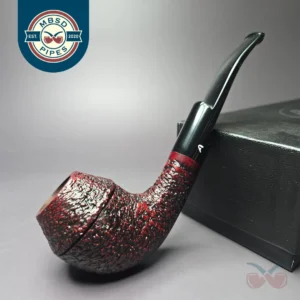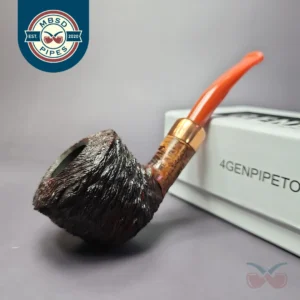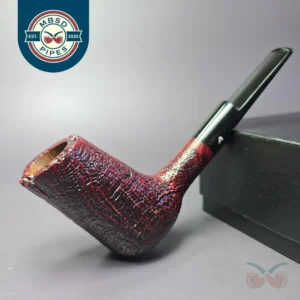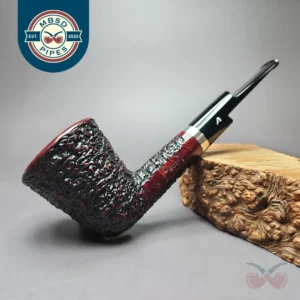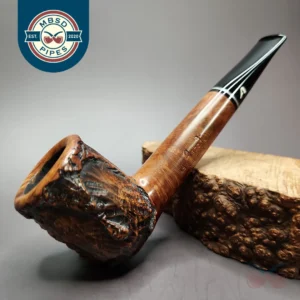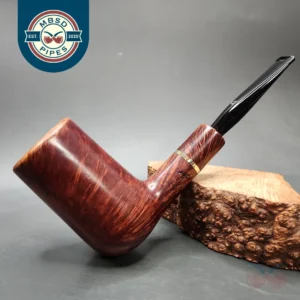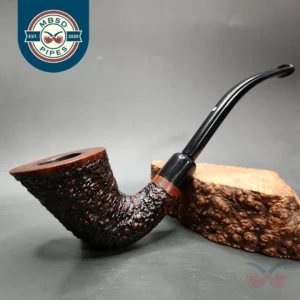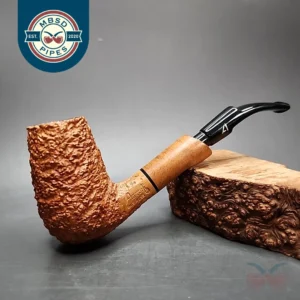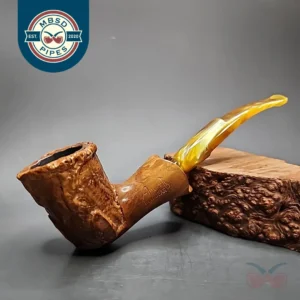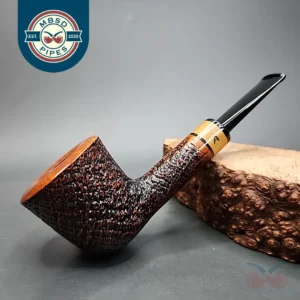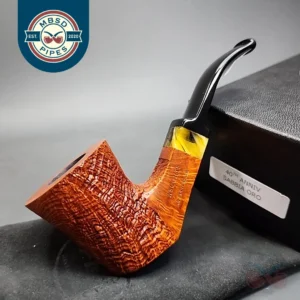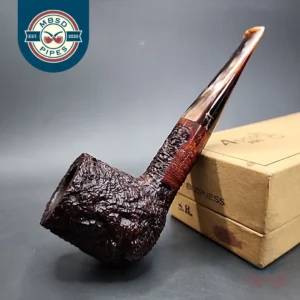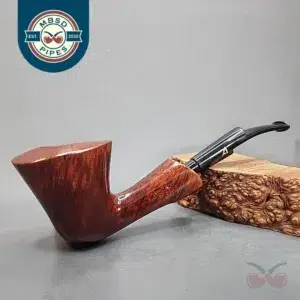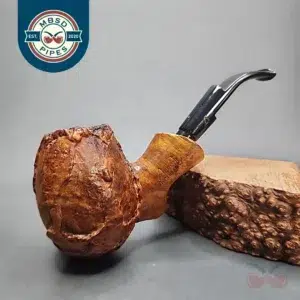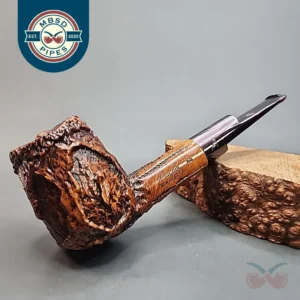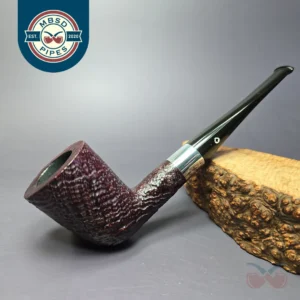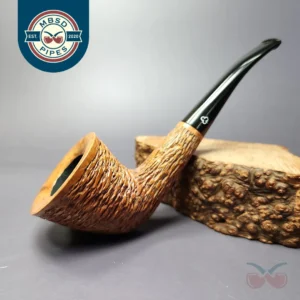Showing all 19 resultsSorted by latest
-
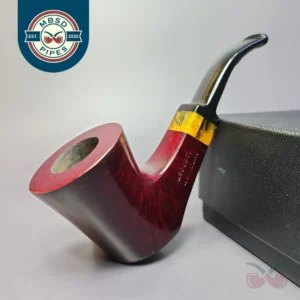
$285.00
Ascorti belongs to a historic lineage in Italian artisan pipe-making. Guiseppe ‘Peppino’ Ascorti was first employed as a pipe-maker in the 1950s, in Carlo Scotti’s Castello workshop in Cantu. There he met Luigi Radice, and in the 1960s the two decided to leave Castello to create their own pipe-making workshop, under the name ‘Caminetto.’ At…
-

$225.00
Ascorti belongs to a historic lineage in Italian artisan pipe-making. Guiseppe ‘Peppino’ Ascorti was first employed as a pipe-maker in the 1950s, in Carlo Scotti’s Castello workshop in Cantu. There he met Luigi Radice, and in the 1960s the two decided to leave Castello to create their own pipe-making workshop, under the name ‘Caminetto.’ At…
-
Ascorti belongs to a historic lineage in Italian artisan pipe-making. Guiseppe ‘Peppino’ Ascorti was first employed as a pipe-maker in the 1950s, in Carlo Scotti’s Castello workshop in Cantu. There he met Luigi Radice, and in the 1960s the two decided to leave Castello to create their own pipe-making workshop, under the name ‘Caminetto.’ At…
-
4th Generation—or, rather, Erik Stokkebye 4th Generation, to use its full name—is a brand of pipes first conceived by Denmark’s Erik Stokkebye (as one would expect), who holds the accomplishment of representing four generations of the Stokkebye family’s involvement in pipes and tobaccos (as one would also expect). Erik Stokkebye himself does not make pipes;…
-
Ascorti belongs to a historic lineage in Italian artisan pipe-making. Guiseppe ‘Peppino’ Ascorti was first employed as a pipe-maker in the 1950s, in Carlo Scotti’s Castello workshop in Cantu. There he met Luigi Radice, and in the 1960s the two decided to leave Castello to create their own pipe-making workshop, under the name ‘Caminetto.’ At…
-
Ascorti belongs to a historic lineage in Italian artisan pipe-making. Guiseppe ‘Peppino’ Ascorti was first employed as a pipe-maker in the 1950s, in Carlo Scotti’s Castello workshop in Cantu. There he met Luigi Radice, and in the 1960s the two decided to leave Castello to create their own pipe-making workshop, under the name ‘Caminetto.’ At…
-
Ascorti belongs to a historic lineage in Italian artisan pipe-making. Guiseppe ‘Peppino’ Ascorti was first employed as a pipe-maker in the 1950s, in Carlo Scotti’s Castello workshop in Cantu. There he met Luigi Radice, and in the 1960s the two decided to leave Castello to create their own pipe-making workshop, under the name ‘Caminetto.’ At…
-
Ascorti belongs to a historic lineage in Italian artisan pipe-making. Guiseppe ‘Peppino’ Ascorti was first employed as a pipe-maker in the 1950s, in Carlo Scotti’s Castello workshop in Cantu. There he met Luigi Radice, and in the 1960s the two decided to leave Castello to create their own pipe-making workshop, under the name ‘Caminetto.’ At…
-
Ascorti belongs to a historic lineage in Italian artisan pipe-making. Guiseppe ‘Peppino’ Ascorti was first employed as a pipe-maker in the 1950s, in Carlo Scotti’s Castello workshop in Cantu. There he met Luigi Radice, and in the 1960s the two decided to leave Castello to create their own pipe-making workshop, under the name ‘Caminetto.’ At…
-
Ascorti belongs to a historic lineage in Italian artisan pipe-making. Guiseppe ‘Peppino’ Ascorti was first employed as a pipe-maker in the 1950s, in Carlo Scotti’s Castello workshop in Cantu. There he met Luigi Radice, and in the 1960s the two decided to leave Castello to create their own pipe-making workshop, under the name ‘Caminetto.’ At…
-
Ascorti belongs to a historic lineage in Italian artisan pipe-making. Guiseppe ‘Peppino’ Ascorti was first employed as a pipe-maker in the 1950s, in Carlo Scotti’s Castello workshop in Cantu. There he met Luigi Radice, and in the 1960s the two decided to leave Castello to create their own pipe-making workshop, under the name ‘Caminetto.’ At…
-
Ascorti belongs to a historic lineage in Italian artisan pipe-making. Guiseppe ‘Peppino’ Ascorti was first employed as a pipe-maker in the 1950s, in Carlo Scotti’s Castello workshop in Cantu. There he met Luigi Radice, and in the 1960s the two decided to leave Castello to create their own pipe-making workshop, under the name ‘Caminetto.’ At…
-
Ascorti belongs to a historic lineage in Italian artisan pipe-making. Guiseppe ‘Peppino’ Ascorti was first employed as a pipe-maker in the 1950s, in Carlo Scotti’s Castello workshop in Cantu. There he met Luigi Radice, and in the 1960s the two decided to leave Castello to create their own pipe-making workshop, under the name ‘Caminetto.’ At…
-
Sale!
Ascorti belongs to a historic lineage in Italian artisan pipe-making. Guiseppe ‘Peppino’ Ascorti was first employed as a pipe-maker in the 1950s, in Carlo Scotti’s Castello workshop in Cantu. There he met Luigi Radice, and in the 1960s the two decided to leave Castello to create their own pipe-making workshop, under the name ‘Caminetto.’ At…
-
Ascorti belongs to a historic lineage in Italian artisan pipe-making. Guiseppe ‘Peppino’ Ascorti was first employed as a pipe-maker in the 1950s, in Carlo Scotti’s Castello workshop in Cantu. There he met Luigi Radice, and in the 1960s the two decided to leave Castello to create their own pipe-making workshop, under the name ‘Caminetto.’ At…
-
Ascorti belongs to a historic lineage in Italian artisan pipe-making. Guiseppe ‘Peppino’ Ascorti was first employed as a pipe-maker in the 1950s, in Carlo Scotti’s Castello workshop in Cantu. There he met Luigi Radice, and in the 1960s the two decided to leave Castello to create their own pipe-making workshop, under the name ‘Caminetto.’ At…
-
Ascorti belongs to a historic lineage in Italian artisan pipe-making. Guiseppe ‘Peppino’ Ascorti was first employed as a pipe-maker in the 1950s, in Carlo Scotti’s Castello workshop in Cantu. There he met Luigi Radice, and in the 1960s the two decided to leave Castello to create their own pipe-making workshop, under the name ‘Caminetto.’ At…
-
Ascorti belongs to a historic lineage in Italian artisan pipe-making. Guiseppe ‘Peppino’ Ascorti was first employed as a pipe-maker in the 1950s, in Carlo Scotti’s Castello workshop in Cantu. There he met Luigi Radice, and in the 1960s the two decided to leave Castello to create their own pipe-making workshop, under the name ‘Caminetto.’ At…
-
Ascorti belongs to a historic lineage in Italian artisan pipe-making. Guiseppe ‘Peppino’ Ascorti was first employed as a pipe-maker in the 1950s, in Carlo Scotti’s Castello workshop in Cantu. There he met Luigi Radice, and in the 1960s the two decided to leave Castello to create their own pipe-making workshop, under the name ‘Caminetto.’ At…



